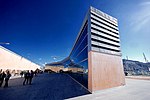Port of Cartagena

The port of Cartagena (Spanish: Puerto de Cartagena) is the port located in Cartagena, Spain. It is the fourth nationwide port in freight traffic behind Algeciras, Valencia and Barcelona. It occupies the eighth place in relation to the number of cruises. 60% of exports and the 80% of imports from the Region of Murcia are made through the port of Cartagena. More than 40% of the tourism that Cartagena receives is made by its port.It historical importance relies on both the good harbour offered by the natural bay and its strategic location near the East–West maritime route linking the Suez Canal to the strait of Gibraltar. It was used by the Punic civilization, and then by Romans. Besides its location, it also was appreciated at the time because of the metal ore mining (argentifourous galenas) in the surrounding mountains as well as the esparto exports.In 2006, the Autoridad Portuaria de Cartagena proposed the expansion of the port with a new dock in El Gorguel. The estimated cost exceeded 1500 million of euros. The Port of Cartagena has two independent docks (Cartagena and Escombreras), separated from each other by a distance of 5 km by road and 1.5 miles by sea.
Excerpt from the Wikipedia article Port of Cartagena (License: CC BY-SA 3.0, Authors, Images).Port of Cartagena
Carretera al Espalmador, Cartagena
Geographical coordinates (GPS) Address Nearby Places Show on map
Geographical coordinates (GPS)
| Latitude | Longitude |
|---|---|
| N 37.583333333333 ° | E -0.98333333333333 ° |
Address
Carretera al Espalmador
30201 Cartagena (Diputación de San Antonio Abad)
Spain
Open on Google Maps









